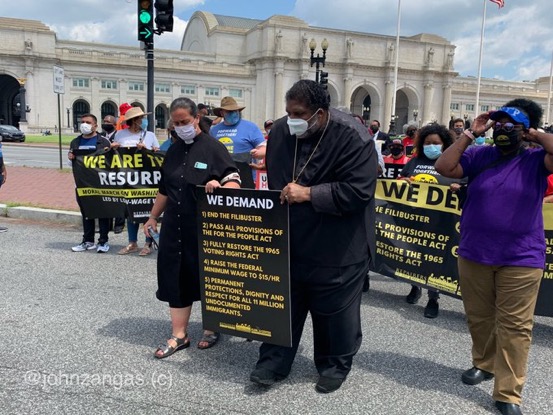
Washington DC — This story could easily have been copied word for word from the newspaper stories of the 1960’s civil rights protests. During the civil rights marches of that era, some 60 years ago, clergymen such as Dr. Martin Luther King and Jesse Jackson, among others, led thousands on direct actions for civil rights, voting rights, fair wages, and housing equality.
On Monday August 2, 2021, Reverend William Barber II walked alongside Jesse Jackson leading several thousand on a revival of that same moral imperative. Their Moral Monday March was to demand that Congress restore the Voting Rights Act, signed by President Johnson on August 8, 1965, by passing the For The People Act, legislation which will strike down at the Federal level, all new voting restrictions passed in States like Georgia, Pennsylvania, Louisiana, and Arizona.
Reverend Barber joined clergy from around the country and working people in calling for a federal minimum wage of $15.00, a rejection of the filibuster, a jim crow era act of Congress which Reverend Barber called an order of procedure steeped in racism, and amnesty for 11 million migrants. “We’re here not to just take a picture, we’re here to take action,” he said.
He chastised both Democratic and Republican legislators who passed a Covid Reief Bill which gave almost 86% of the trillion it earmarked in relief to corporations while leaving workers behind.
After his speech, Reverend Barber led dozens of other clergy who had come from around the country, on a march to the U.S. Capitol, with hundreds of followers behind him. His golden cross stood out on his wide chest against the pitch black cloth suit he wore. He labored in the oppressive heat up the hill to the Capitol, Summer heat took effect on the large man and several times he had to stop and cool down. Reverend Jesse Jackson, now 79 years old, also walked very slowly up the hill with the heat slowing him and he too had to rest often. At times he also needed assistance from others but he completed the march with all the other marchers.
As they arrived at the top of the hill and past the grounds of the U.S. Capitol — they did not attempt to step on the grounds proper — Capitol Police swarmed around them. A Capitol policewoman read two warnings over a loudspeaker for them to leave the roadway or face arrest. So ushers urged the marchers out of the street and onto the confines of the narrow sidewalk to avoid immediate arrest.
It was clear that the Capitol Police strategy and tactics had changed from demonstrations of the past year. The difference: Capitol Police enforcement of street obstruction misdemeanor codes on this day was exceptionally strict in comparison to enforcement of U.S. Capitol building access restrictions during the riots of January 6, earlier this year.
The marchers avoided arrest at first but they intended to be arrested from the beginning of their march. They were carrying a message to Legislators that they would not stand quietly while an ongoing impasse in the Senate fails to restore the Voting Rights Act and strike down voting suppression laws which are now being written with some already on the books in 18 states. In the States that have already enacted them, there are 30 new vote suppression laws, that have been passed by GOP legislators since Trump lost the election last year. These voter restrictions were designed to make it more difficult for voters to get access to the ballot box, according to a published report.
The marchers walked past the Capitol and around to the Supreme Court singing songs handed down by the civil rights activists about voting rights and equal rights in the 1960s.
Finally they arrived at the Senate Hart Building, a scene of many demonstrations and mass arrests in the past. Reverend Barber sent five activists to its doors to request entry but Capitol Police refused them to admit them. He called them back and then organized a mass blockade of the street outside the Hart Senate building.
Reverends Barber and Jackson were both arrested for blocking the street during a demonstration, followed by several hundred other protesters.
The Brennan Center tracks State laws being enacted involving voting rights, outlining the easing and restrictions thereof.
 RSS Feed
RSS Feed















 August 8th, 2021
August 8th, 2021  Awake Goy
Awake Goy  Posted in
Posted in  Tags:
Tags: 













